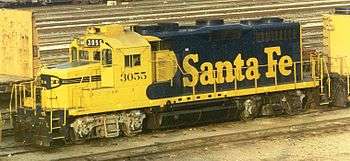Blomberg B


The Blomberg B is a "B" diesel locomotive truck. These trucks were the standard EMD four wheel truck from the FT until the GP60. EMD introduced the truck in 1939. Unofficially it is named after Martin Blomberg, who joined the company the year before. The truck was derived from an earlier three axle truck (A1A) designed by Blomberg (described in U.S. Patent 2,189,125, filed January 29, 1938, and approved February 6, 1940), and was used starting with the FT.
Identification
Blomberg trucks can be identified by their prominent outside swing hangers, which afford a better ride during side-to-side movement. The outside placement has the advantage of widening its spring base from 56 to 96 inches (1,422 to 2,438 mm).
Due to the swinging hanger suspension system these trucks are commonly referred to in the railroad business as "swing hanger trucks". The term "Blomberg" truck isn't used even in some railroad training literature that specifically describes truck types.
A popular modification by railroads in later years was reducing the number of brake shoes from 8 to 4 by reconfiguring the double-clasp brake rigging, removing one brake shoe per wheel. This can give the Blomberg B a similar appearance of later Blomberg M trucks.
Although possibly a few exceptions exist, where a customer specifically requested plain bearings, almost all Blomberg B and M trucks (freight), and all Blomberg A1A trucks (passenger) which preceded these, were fitted with roller bearings.
Blomberg B trucks are occasionally seen on competitors' locomotives, the General Electric Universal Series in particular, where the railroad has requested re-use of traded-in EMD trucks and possibly also EMD traction motors on new GE locomotives.
M version
A modified (M) version of the truck called the Blomberg M was used starting with the four-axle Dash 2 series locomotives. Hydraulic snubbers (shocks) were used on diagonally opposite (front right and rear left) journals, and the leaf spring suspension was replaced with rubber pads. This version had only one brake actuating cylinder per side and revised brake rigging using threaded adjusters, reducing the number of brake shoes to 4 versus 8 on the earlier B model.
There is also a later variation of the Blomberg M found on the GP60 and F59PH models. The main spotting features of this version are leaf spring suspension (as opposed to rubber pads) and exposed roller bearing ends, along with damper shocks between the trucks and locomotive carbody to reduce sway. Similar looking trucks can be found under modern MPI MPXpress locomotives.
The "rubber pads" seen in the trucks in place of leaf springs are actually springs themselves. They're constructed of laminated layers of rubber cushioning material and steel plates and they do provide suspension and cushioning effect.
